Hyundai Santa Fe 2014 Owners Manual
Manufacturer: HYUNDAI, Model Year: 2014, Model line: Santa Fe, Model: Hyundai Santa Fe 2014Pages: 711, PDF Size: 14.72 MB
Page 91 of 711
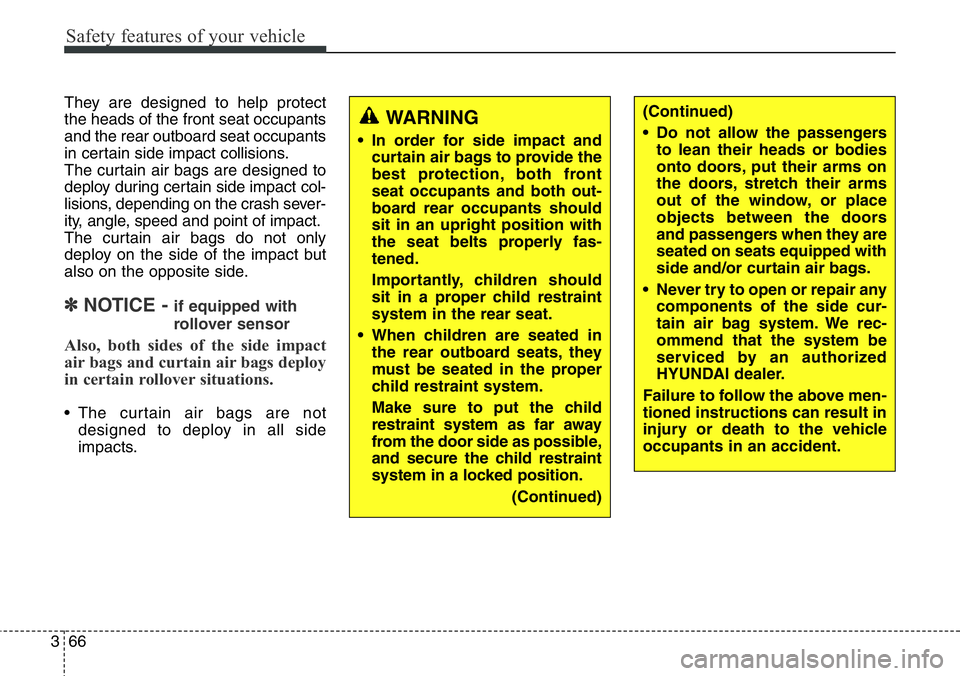
Safety features of your vehicle
66 3
They are designed to help protect
the heads of the front seat occupants
and the rear outboard seat occupants
in certain side impact collisions.
The curtain air bags are designed to
deploy during certain side impact col-
lisions, depending on the crash sever-
ity, angle, speed and point of impact.
The curtain air bags do not only
deploy on the side of the impact but
also on the opposite side.
✽NOTICE - if equipped with
rollover sensor
Also, both sides of the side impact
air bags and curtain air bags deploy
in certain rollover situations.
• The curtain air bags are not
designed to deploy in all side
impacts.
(Continued)
• Do not allow the passengers
to lean their heads or bodies
onto doors, put their arms on
the doors, stretch their arms
out of the window, or place
objects between the doors
and passengers when they are
seated on seats equipped with
side and/or curtain air bags.
• Never try to open or repair any
components of the side cur-
tain air bag system. We rec-
ommend that the system be
serviced by an authorized
HYUNDAI dealer.
Failure to follow the above men-
tioned instructions can result in
injury or death to the vehicle
occupants in an accident.WARNING
• In order for side impact and
curtain air bags to provide the
best protection, both front
seat occupants and both out-
board rear occupants should
sit in an upright position with
the seat belts properly fas-
tened.
Importantly, children should
sit in a proper child restraint
system in the rear seat.
• When children are seated in
the rear outboard seats, they
must be seated in the proper
child restraint system.
Make sure to put the child
restraint system as far away
from the door side as possible,
and secure the child restraint
system in a locked position.
(Continued)
Page 92 of 711
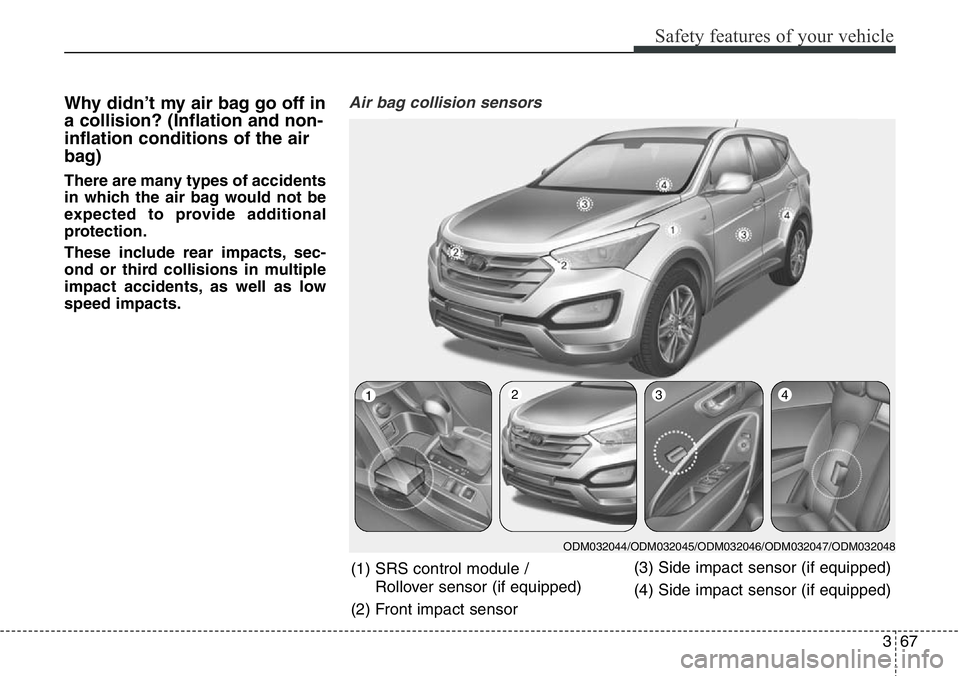
367
Safety features of your vehicle
Why didn’t my air bag go off in
a collision? (Inflation and non-
inflation conditions of the air
bag)
There are many types of accidents
in which the air bag would not be
expected to provide additional
protection.
These include rear impacts, sec-
ond or third collisions in multiple
impact accidents, as well as low
speed impacts.
Air bag collision sensors
(1) SRS control module /
Rollover sensor (if equipped)
(2) Front impact sensor(3) Side impact sensor (if equipped)
(4) Side impact sensor (if equipped)
ODM032044/ODM032045/ODM032046/ODM032047/ODM032048
1234
Page 93 of 711
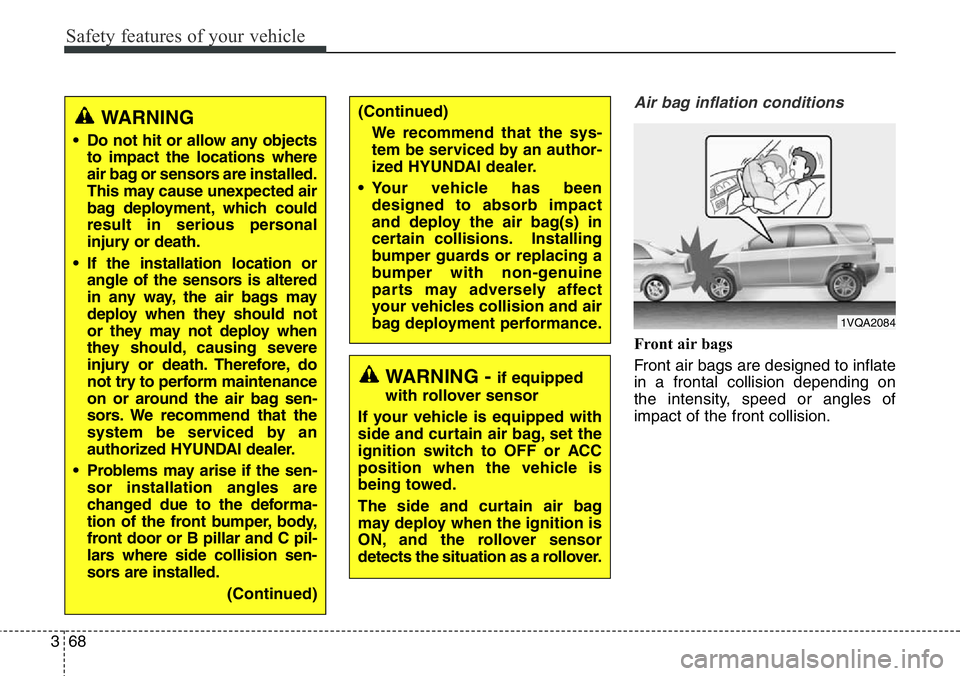
Safety features of your vehicle
68 3
Air bag inflation conditions
Front air bags
Front air bags are designed to inflate
in a frontal collision depending on
the intensity, speed or angles of
impact of the front collision.
WARNING - if equipped
with rollover sensor
If your vehicle is equipped with
side and curtain air bag, set the
ignition switch to OFF or ACC
position when the vehicle is
being towed.
The side and curtain air bag
may deploy when the ignition is
ON, and the rollover sensor
detects the situation as a rollover.
WARNING
• Do not hit or allow any objects
to impact the locations where
air bag or sensors are installed.
This may cause unexpected air
bag deployment, which could
result in serious personal
injury or death.
• If the installation location or
angle of the sensors is altered
in any way, the air bags may
deploy when they should not
or they may not deploy when
they should, causing severe
injury or death. Therefore, do
not try to perform maintenance
on or around the air bag sen-
sors. We recommend that the
system be serviced by an
authorized HYUNDAI dealer.
• Problems may arise if the sen-
sor installation angles are
changed due to the deforma-
tion of the front bumper, body,
front door or B pillar and C pil-
lars where side collision sen-
sors are installed.
(Continued)
(Continued)
We recommend that the sys-
tem be serviced by an author-
ized HYUNDAI dealer.
• Your vehicle has been
designed to absorb impact
and deploy the air bag(s) in
certain collisions. Installing
bumper guards or replacing a
bumper with non-genuine
parts may adversely affect
your vehicles collision and air
bag deployment performance.
1VQA2084
Page 94 of 711
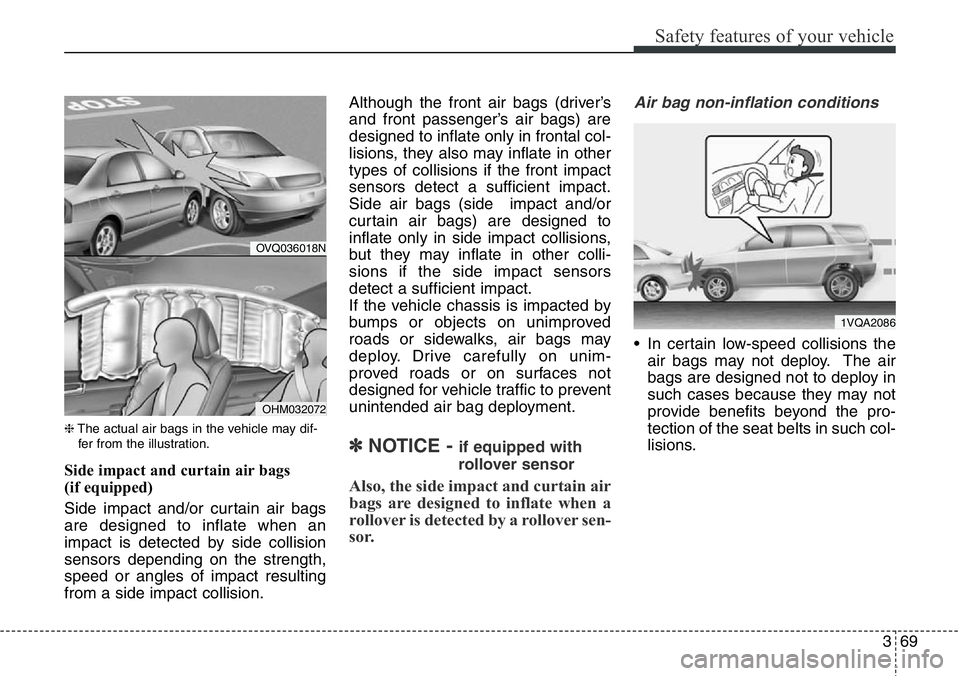
369
Safety features of your vehicle
❈The actual air bags in the vehicle may dif-
fer from the illustration.
Side impact and curtain air bags
(if equipped)
Side impact and/or curtain air bags
are designed to inflate when an
impact is detected by side collision
sensors depending on the strength,
speed or angles of impact resulting
from a side impact collision.Although the front air bags (driver’s
and front passenger’s air bags) are
designed to inflate only in frontal col-
lisions, they also may inflate in other
types of collisions if the front impact
sensors detect a sufficient impact.
Side air bags (side impact and/or
curtain air bags) are designed to
inflate only in side impact collisions,
but they may inflate in other colli-
sions if the side impact sensors
detect a sufficient impact.
If the vehicle chassis is impacted by
bumps or objects on unimproved
roads or sidewalks, air bags may
deploy. Drive carefully on unim-
proved roads or on surfaces not
designed for vehicle traffic to prevent
unintended air bag deployment.
✽NOTICE - if equipped with
rollover sensor
Also, the side impact and curtain air
bags are designed to inflate when a
rollover is detected by a rollover sen-
sor.
Air bag non-inflation conditions
• In certain low-speed collisions the
air bags may not deploy. The air
bags are designed not to deploy in
such cases because they may not
provide benefits beyond the pro-
tection of the seat belts in such col-
lisions.
1VQA2086
OVQ036018N
OHM032072
Page 95 of 711
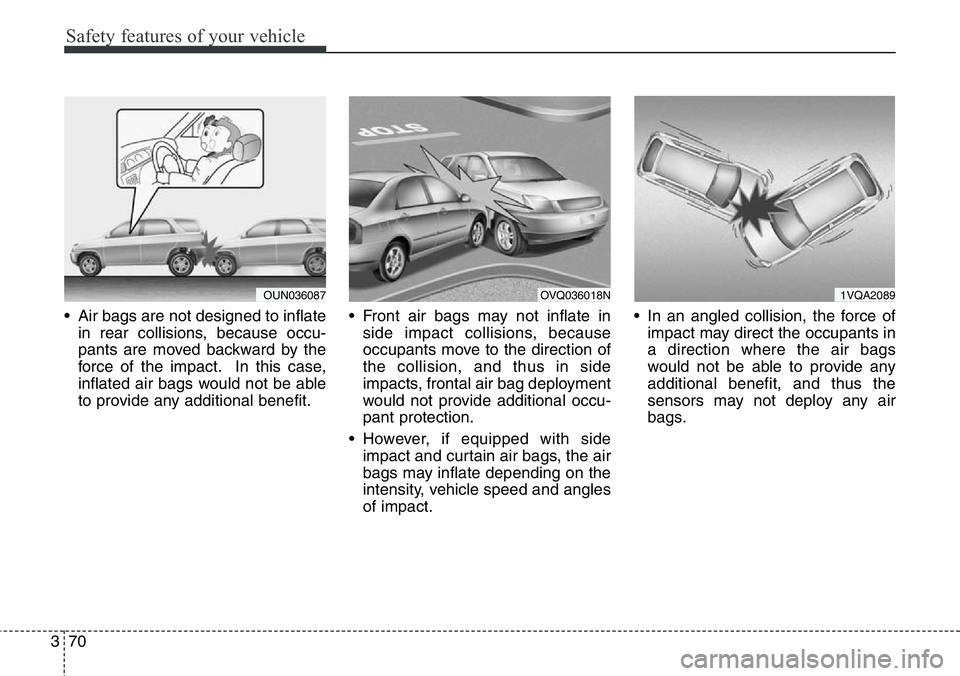
Safety features of your vehicle
70 3
• Air bags are not designed to inflate
in rear collisions, because occu-
pants are moved backward by the
force of the impact. In this case,
inflated air bags would not be able
to provide any additional benefit.• Front air bags may not inflate in
side impact collisions, because
occupants move to the direction of
the collision, and thus in side
impacts, frontal air bag deployment
would not provide additional occu-
pant protection.
• However, if equipped with side
impact and curtain air bags, the air
bags may inflate depending on the
intensity, vehicle speed and angles
of impact.• In an angled collision, the force of
impact may direct the occupants in
a direction where the air bags
would not be able to provide any
additional benefit, and thus the
sensors may not deploy any air
bags.
OUN0360871VQA2089OVQ036018N
Page 96 of 711

371
Safety features of your vehicle
• Just before impact, drivers often
brake heavily. Such heavy braking
lowers the front portion of the vehi-
cle causing it to “ride” under a vehi-
cle with a higher ground clearance.
Air bags may not inflate in this
"under-ride" situation because
deceleration forces that are detect-
ed by sensors may be significantly
reduced by such “under-ride” colli-
sions.• Front air bags may not inflate in
rollover accidents because front air
bag deployment would not provide
additional occupant protection.
✽NOTICE - if equipped with
rollover sensor
However, if equipped with side
impact and curtain air bags, the air
bags may inflate in a rollover, when
it is detected by the rollover sensor.
✽NOTICE - without rollover
sensor
However, side and/or curtain air
bags may inflate when the vehicle is
rolled over by a side impact colli-
sion, if the vehicle is equipped with
side impact air bags and curtain air
bags.
1VQA20901VQA2091
Page 97 of 711
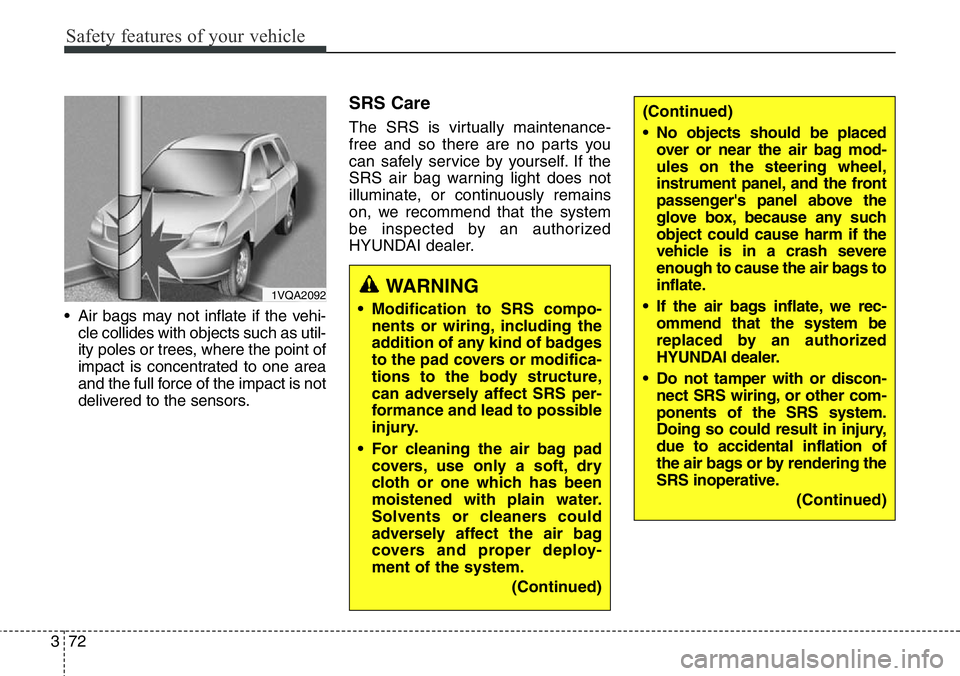
Safety features of your vehicle
72 3
• Air bags may not inflate if the vehi-
cle collides with objects such as util-
ity poles or trees, where the point of
impact is concentrated to one area
and the full force of the impact is not
delivered to the sensors.
SRS Care
The SRS is virtually maintenance-
free and so there are no parts you
can safely service by yourself. If the
SRS air bag warning light does not
illuminate, or continuously remains
on, we recommend that the system
be inspected by an authorized
HYUNDAI dealer.
1VQA2092WARNING
• Modification to SRS compo-
nents or wiring, including the
addition of any kind of badges
to the pad covers or modifica-
tions to the body structure,
can adversely affect SRS per-
formance and lead to possible
injury.
• For cleaning the air bag pad
covers, use only a soft, dry
cloth or one which has been
moistened with plain water.
Solvents or cleaners could
adversely affect the air bag
covers and proper deploy-
ment of the system.
(Continued)
(Continued)
• No objects should be placed
over or near the air bag mod-
ules on the steering wheel,
instrument panel, and the front
passenger's panel above the
glove box, because any such
object could cause harm if the
vehicle is in a crash severe
enough to cause the air bags to
inflate.
• If the air bags inflate, we rec-
ommend that the system be
replaced by an authorized
HYUNDAI dealer.
• Do not tamper with or discon-
nect SRS wiring, or other com-
ponents of the SRS system.
Doing so could result in injury,
due to accidental inflation of
the air bags or by rendering the
SRS inoperative.
(Continued)
Page 98 of 711
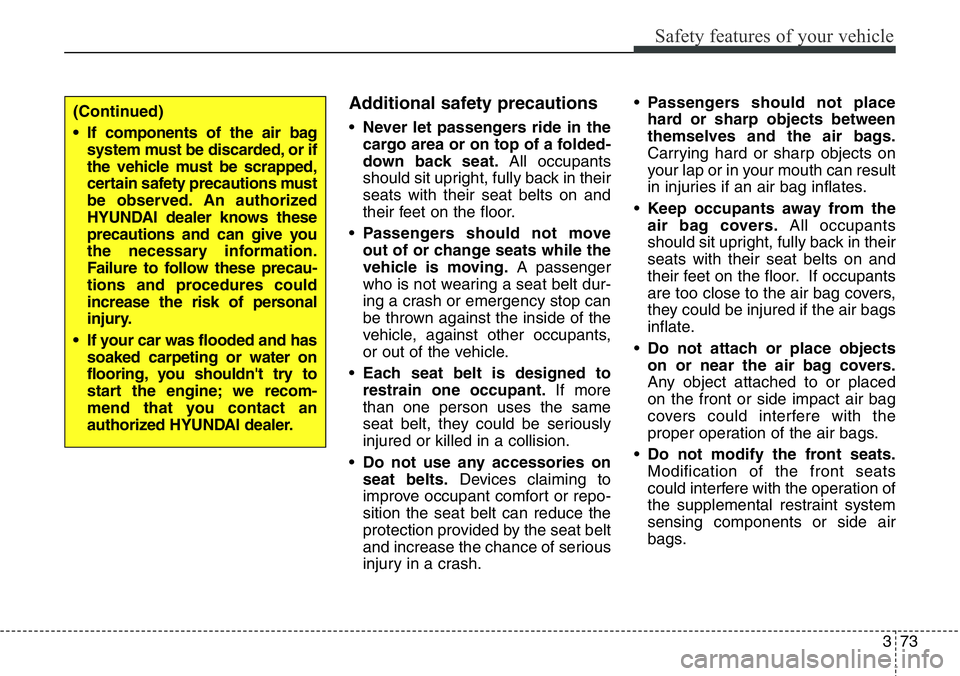
373
Safety features of your vehicle
Additional safety precautions
•Never let passengers ride in the
cargo area or on top of a folded-
down back seat.All occupants
should sit upright, fully back in their
seats with their seat belts on and
their feet on the floor.
•Passengers should not move
out of or change seats while the
vehicle is moving.A passenger
who is not wearing a seat belt dur-
ing a crash or emergency stop can
be thrown against the inside of the
vehicle, against other occupants,
or out of the vehicle.
•Each seat belt is designed to
restrain one occupant.If more
than one person uses the same
seat belt, they could be seriously
injured or killed in a collision.
•Do not use any accessories on
seat belts.Devices claiming to
improve occupant comfort or repo-
sition the seat belt can reduce the
protection provided by the seat belt
and increase the chance of serious
injury in a crash.•Passengers should not place
hard or sharp objects between
themselves and the air bags.
Carrying hard or sharp objects on
your lap or in your mouth can result
in injuries if an air bag inflates.
•Keep occupants away from the
air bag covers.All occupants
should sit upright, fully back in their
seats with their seat belts on and
their feet on the floor. If occupants
are too close to the air bag covers,
they could be injured if the air bags
inflate.
•Do not attach or place objects
on or near the air bag covers.
Any object attached to or placed
on the front or side impact air bag
covers could interfere with the
proper operation of the air bags.
•Do not modify the front seats.
Modification of the front seats
could interfere with the operation of
the supplemental restraint system
sensing components or side air
bags.(Continued)
• If components of the air bag
system must be discarded, or if
the vehicle must be scrapped,
certain safety precautions must
be observed. An authorized
HYUNDAI dealer knows these
precautions and can give you
the necessary information.
Failure to follow these precau-
tions and procedures could
increase the risk of personal
injury.
• If your car was flooded and has
soaked carpeting or water on
flooring, you shouldn't try to
start the engine; we recom-
mend that you contact an
authorized HYUNDAI dealer.
Page 99 of 711
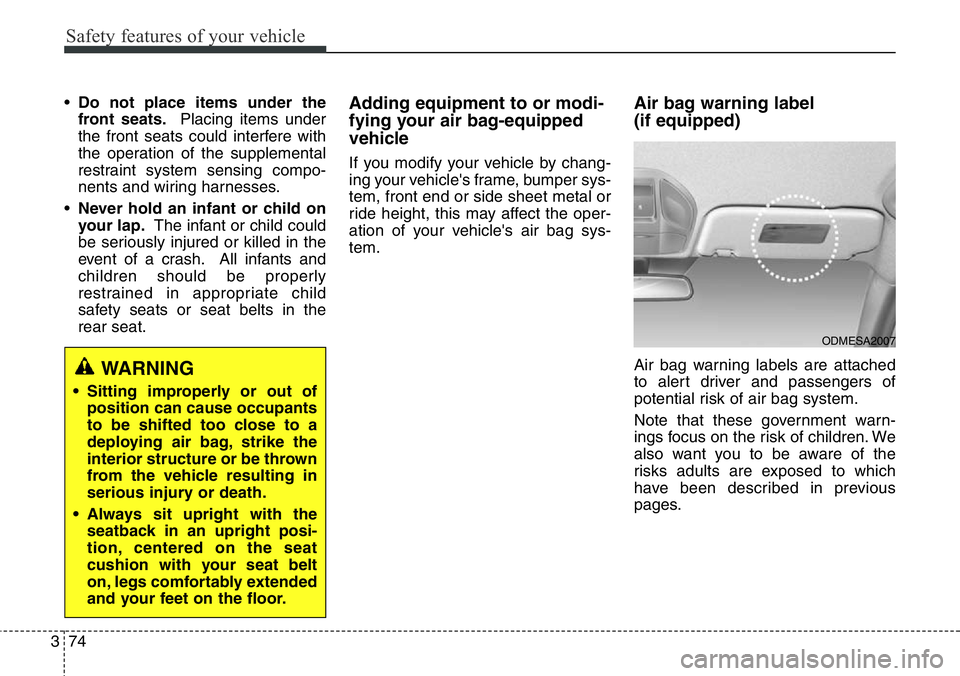
Safety features of your vehicle
74 3
•Do not place items under the
front seats.Placing items under
the front seats could interfere with
the operation of the supplemental
restraint system sensing compo-
nents and wiring harnesses.
•Never hold an infant or child on
your lap.The infant or child could
be seriously injured or killed in the
event of a crash. All infants and
children should be properly
restrained in appropriate child
safety seats or seat belts in the
rear seat.Adding equipment to or modi-
fying your air bag-equipped
vehicle
If you modify your vehicle by chang-
ing your vehicle's frame, bumper sys-
tem, front end or side sheet metal or
ride height, this may affect the oper-
ation of your vehicle's air bag sys-
tem.
Air bag warning label
(if equipped)
Air bag warning labels are attached
to alert driver and passengers of
potential risk of air bag system.
Note that these government warn-
ings focus on the risk of children. We
also want you to be aware of the
risks adults are exposed to which
have been described in previous
pages.WARNING
• Sitting improperly or out of
position can cause occupants
to be shifted too close to a
deploying air bag, strike the
interior structure or be thrown
from the vehicle resulting in
serious injury or death.
• Always sit upright with the
seatback in an upright posi-
tion, centered on the seat
cushion with your seat belt
on, legs comfortably extended
and your feet on the floor.
ODMESA2007
Page 100 of 711
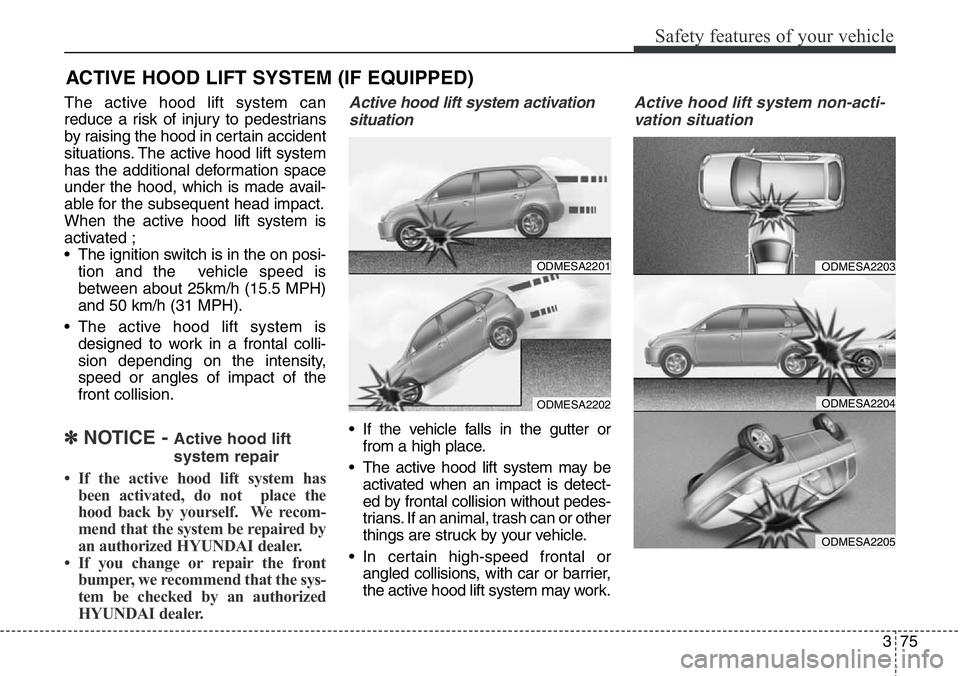
375
Safety features of your vehicle
ACTIVE HOOD LIFT SYSTEM (IF EQUIPPED)
The active hood lift system can
reduce a risk of injury to pedestrians
by raising the hood in certain accident
situations. The active hood lift system
has the additional deformation space
under the hood, which is made avail-
able for the subsequent head impact.
When the active hood lift system is
activated ;
• The ignition switch is in the on posi-
tion and the vehicle speed is
between about 25km/h (15.5 MPH)
and 50 km/h (31 MPH).
• The active hood lift system is
designed to work in a frontal colli-
sion depending on the intensity,
speed or angles of impact of the
front collision.
✽NOTICE - Active hood lift
system repair
• If the active hood lift system has
been activated, do not place the
hood back by yourself. We recom-
mend that the system be repaired by
an authorized HYUNDAI dealer.
• If you change or repair the front
bumper, we recommend that the sys-
tem be checked by an authorized
HYUNDAI dealer.
Active hood lift system activation
situation
• If the vehicle falls in the gutter or
from a high place.
• The active hood lift system may be
activated when an impact is detect-
ed by frontal collision without pedes-
trians. If an animal, trash can or other
things are struck by your vehicle.
• In certain high-speed frontal or
angled collisions, with car or barrier,
the active hood lift system may work.
Active hood lift system non-acti-
vation situation
ODMESA2201
ODMESA2202
ODMESA2203
ODMESA2204
ODMESA2205